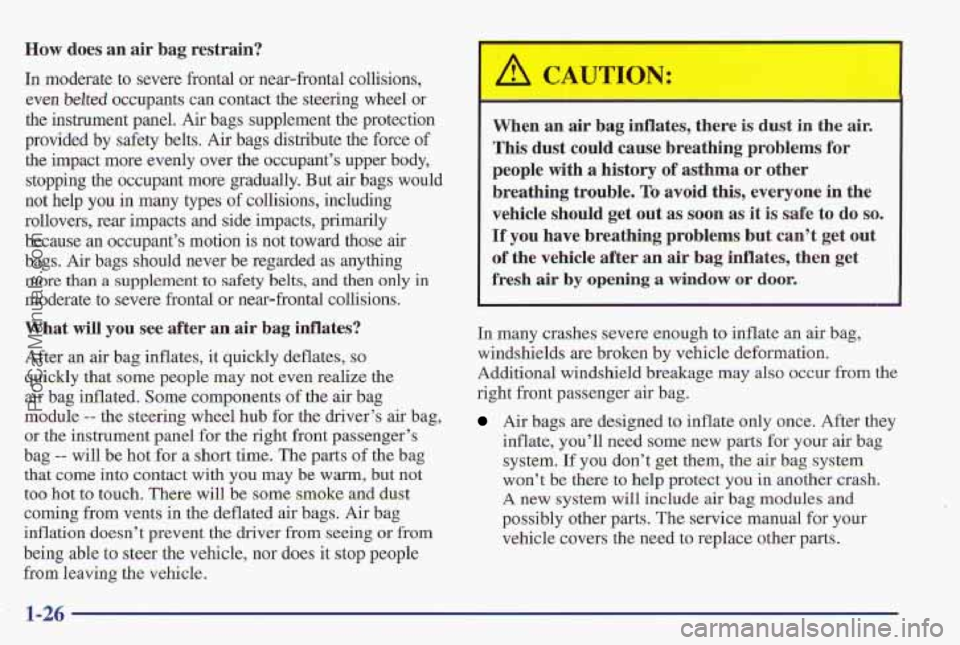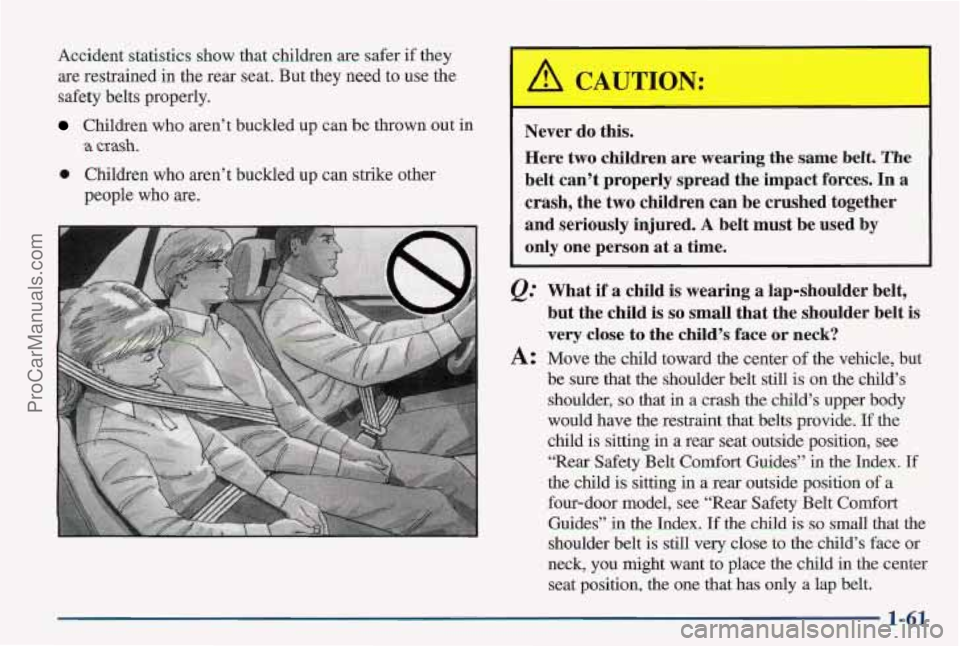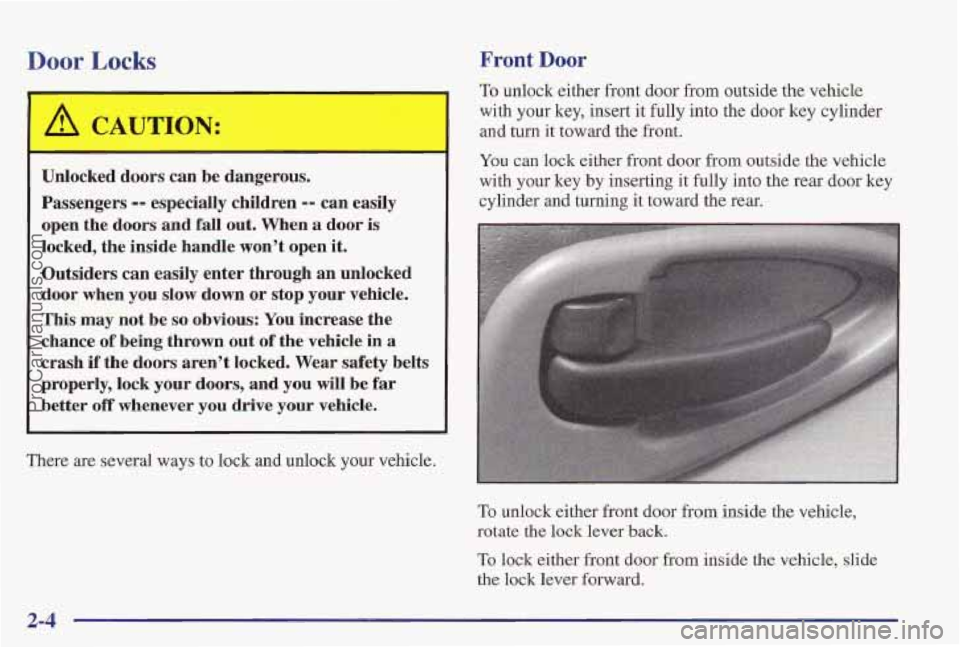1997 PONTIAC PONTIAC tow
[x] Cancel search: towPage 34 of 419

How does an air bag restrain?
In moderate to severe frontal or near-frontal collisions,
even
belted occupants can contact the steering wheel or
the instrument panel. Air bags supplement the protection
provided by safety belts.
Air bags distribute the force of
the impact more evenly over the occupant’s upper bady,
stopping
the occupant more gradually. But air bags would
not help
you in many types of collisions, including
rollovers, rear impacts and side impacts, primarily
because an occupant’s motion is not toward those air
bags.
Air bags should never be regarded as anything
more
than a supplement tn safety belts, and then only in
moderate to severe front:.- ~r newfrontal collisions.
What will you see after an air bag inflates?
After an air bag inflates, it quickly deflates, so
quickly that some people may not even realize the
air bag inflated. Some components o’f the air bag
module
-- the steering wheel hub for the driver’s air bag,
or
the instrument panel for the right front passenger’s
bag
-- will be hot for a short time. The parts of the bag
that come into contact with you
may be warm, but not
too hot
to touch. There will be some smoke and dust
coming
from vents in the deflated air bags. Air bag
inflation doesn’t prevent the driver from seeing or from
being able to steer the vehicle, nor
does it stop people
from leaving the vehkle.
When an air bag inflates, there is dust in the air.
This dust could cause breathing problems
for
people with a history of asthma or other
breathing trouble.
To avoid this, everyone in the
vehicle should get out as
soon as it is safe to do so.
If you have breathing problems but can’t get out
of the vehicle after an air bag inflates, then get
fresh air by opening a window or door.
In many crashes severe enough ta inflate an air bag,
windshields are broken
by vehicle deformation.
Additional windshield breakage may also occur from the
right front passenger air bag.
Air bags are designed to inflate only once. After they
inflate, you’ll need
some new parts for your air bag
system. If you don’t get them, the
air bag system
won’t be there to help protect you
in another crash.
A new system will include air bag modules and
possibly other parts. The service manual for your
vehicle covers the need to replace other parts.
1-26
ProCarManuals.com
Page 69 of 419

Accident statistics show that children are safer if they
are restrained in the rear seat. But they need to use the
safety belts properly.
Children who aren’t buckled up can be thrown out in
a crash.
0 Children who aren’t buckled up can strike other
people who
are.
Never do this.
Here two children are wearing the same
belt. The
b’elt can’t properly spread the impact forces. In a
crash, the
two children can be crushed together
and seriously injured.
A belt must be used by
only one person
at a time.
Q.” What if a child is wearing a lap-shoulder belt,
but the child
is so small that the shoulder belt is
very close to the child’s face or neck?
A: Move the child toward the center of the vehicle, but
be sure that the shoulder belt still is on
the child’s
shoulder,
so that in a crash the child’s upper body
would have the restraint that belts provide. If the
child is sitting in a rear seat outside position, see
“Rear Safety Belt
Comfort Guides” in the Index. If
the child is sitting in a rear outside position of a
four-door model, see “Rear Safety Belt
Comfort
Guides” in the Index. If the child is so small that the
shoulder belt is still very close to
the child’s face or
neck, you might want
to place the child in the center
seat position, the one that has only
a lap belt.
1-61
ProCarManuals.com
Page 78 of 419

Door Locks Front Door
Unlocked doors can be dangerous.
Passengers
-- especially children -- can easily
open the doors and fall
out. When a door is
locked, the inside handle won’t open
it.
Outsiders can easily enter through an unlocked
door when you slow down or stop your vehicle.
This may not
be so obvious: You increase the
chance of being thrown
out of the vehicle in a
crash if the doors aren’t locked. Wear safety belt:
properly, lock your
doors, and you will be far
better off whenever you drive your vehicle.
To unlock either front door from outside the vehicle
with your key, insert it fully into the door key cylinder
and turn it toward the front.
You can lock either front door from outside the vehicle
with your key by inserting it fully into the rear door key
cylinder and turning it toward the rear.
There are several ways to lock and unlock your vehicle.
To unlock either front door from inside the vehicle,
rotate the lock
lever back.
To lock either front door from inside the vehicle, slide
the
lock lever forward.
2-4
ProCarManuals.com
Page 89 of 419

New Vehicle “Break-In”
NOTICE:
Your modern Pontiac doesn’t need an elaborate
“break-in.” But
it will perform better in the long
run
if you follow these guidelines:
Don’t drive at any one speed -- fast or
slow -- for the first 500 miles (805 km).
Don’t make full-throttle starts.
200 miles (322 km) or so. During this time
your new brake linings aren’t yet broken
in. Hard stops with new linings can mean
premature wear and earlier replacement.
Follow this breaking-in guideline every
time
you get new brake linings.
Don’t tow a trailer during break-in. See
“Towing
a Trailer’’ in the Index for
more information.
0 Avoid making hard stops for the first
Ignition Positions
C
With the ignition key in the ignition switch, you can turn
the switch to five positions:
ACCESSORY (A): This position lets you use things
like the radio and windshield wipers when the engine is
off. To use ACCESSORY, push in the key and turn it
toward you. Your steering wheel will stay locked.
LOCK (B): Before you put the key into the ignition
switch, the switch is in
LOCK. It’s also the only position
in which you can remove your key.
This position locks
your ignition, steering wheel and transaxle. It’s a
theft-deterrent feature.
2-15
ProCarManuals.com
Page 90 of 419

OFF (C): This position lets you turn off the engine but
still
turn the steering wheel. It doesn’t lock the steering
wheel like LOCK. Use OFF if you must have your
vehicle
pushed or towed.
RUN (D): This position is where the key returns
after
you start your vehicle. With the engine off, you
can use RUN to display some of your warning and
indicator lights.
START (E): This position starts your engine.
A warning chime will sound if you open the driver’s
door when the ignition is in OFF, LOCK or
ACCESSORY and the key is in the ignition,
~
NOTICE:
~~
If your key seems stuck in LOCK and you can’t
turn it, be sure your are using the correct key; if
so is it all the way in? If it is, then turn the
steering wheel left and right while yon turn the
key hard.
But turn the key only with your hand.
Using
a tool to force it could break the key or the
ignition
switch. If none of this works, then your
vehicle needs service.
Starting Your Engine
Move your shift lever to PARK (P) or NEUTRAL (N).
Your engine won’t start in any other position -- that’s a
safety feature. To restart when you’re already moving,
use NEUTRAL
(N) only.
NOTICE:
Don’t try to shift to PARK (P) if your Pontiac is
moving. If you do, you could, damage the
transaxle. Shift to
PARK (P) only when your
vehicle
is stopped.
1. Without pushing the accelerator pedal, turn your
ignition key to
START. When the engine starts, let
go of the key. The idle speed will go down as your
engine gets warm.
2-16
ProCarManuals.com
Page 91 of 419

NOTICE:
Holding your key in START for longer than
15 seconds at a time will cause your battery to be
drained much sooner. And the excessive heat can
damage your starter motor.
2. If it doesn’t start right away, hold your key in
START for about three to five seconds at a time until
your engine starts. Wait about
15 seconds between
each
try to help avoid draining your battery.
3. If your engine still won’t start (or starts but then
stops), it could be flooded with too much gasoline.
Try pushing
your accelerator pedal all the way to the
floor and holding it there as you hold the key in
START for about three seconds.
If the vehicle starts
briefly but then stops again, do the same thing, but
this time keep the pedal down for five or six seconds.
This clears the extra gasoline from the engine.
After waiting about
15 seconds, repeat the normal
starting procedure.
NOTICE:
Your engine is designed to work with the
electronics
in your vehicle. If you add electrical
parts or accessories, you could change the way
the engine operates. Before adding electrical
equipment, check with your dealer.
If you don’t,
your engine might not perform properly.
If you ever have to have your vehicle towed, see
the part of this manual that tells how to
do it
without damaging your vehicle. See “Towing
Your Vehicle” in the Index.
2-17
ProCarManuals.com
Page 93 of 419

Automatic Transaxle Operation
Your automatic transaxle may have a shift lever on the
steering column
or on the console between the seats.
Maximum engine speed is limited when you’re in
PARK (P) or NEUTRAL (N), to protect driveline
components from improper operation. There
are several different positions for your shift lever.
PARK (P): This locks your front wheels. It’s the best
position to use when you start your engine because your
vehicle can’t move easily.
I
It is dangerous to get out of your vehicle if the
shift lever is not fully in PARK (P) with the
parking brake firmly set. Your vehicle can roll.
Don’t leave your vehicle when the engine is
running unless you have to.
If you have left the
engine running, the vehicle can move suddenly.
You or others could be injured.
To be sure your
vehicle won’t move, even when you’re
on fairly
level ground, always set your parking brake and
move the shift lever to
PARK (P).
See “Shifting Into PARK (P)” in the Index. If
you’re pulling
a trailer, see “Towing a Trailer” in
the Index.
ProCarManuals.com
Page 94 of 419

Make sure the shift lever is fully into PARK (P) NEUTRAL (N): In this position, your engine
range before starting the engine.
Your Pontiac has a doesn’t connect with the wheels. To restart when you’re
brake-transaxle shift interlock.
You must fully apply already moving, use NEUTRAL (N) only. Also, use
your regular brakes before
you can shift from PARK (P) NEUTRAL (N) when your vehicle is being towed.
when the ignition is in
RUN. If you cannot shift out of
PARK (P), ease pressure on the shift lever by pushing
it all the way into PARK (P) while keeping the brake
pedal pushed down. Release the shift lever button
if you
have a console shift. Then move the shift lever out of
PARK (P), being sure to press the shift lever button
if you have a console shift. See “Shifting Out of
PARK (P)” in the Index.
REVERSE (R): Use this gear to back up.
Shifting out of PARK (P) or NEUTRAL (N) while
your engine is “racing” (running at high speed)
is
dangerous. Unless your foot is firmly on the
brake pedal, your vehicle could move very
rapidly.
You could lose ‘control and hit people
I 1 I or objects. Don’t shift out of PARK (P) or I
NOTICE: NEUTRAL (N) while your engine is racing.
~ -
I Shifting to REVERSE (R) while your vehicle is I
moving forward could damage your transaxle.
Shift
to REVERSE (R) only after your vehicle
is stopped. NOTICE:
I I I I Damage to your transaxle caused by shifting out
To rock your vehicle back and forth to get out of snow,
ice
or sand without damaging your transaxle, see racing isn’t covered by your warranty. I
of PARK (P) or NEUTRAL (N) with the engine
“Stuck: In Sand, Mud, Ice or Snow” in the Index,
~ ~~
2-20
ProCarManuals.com